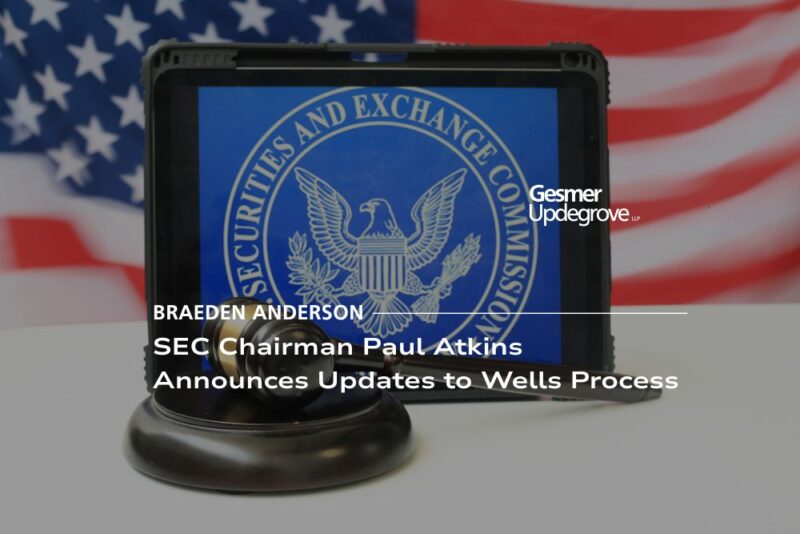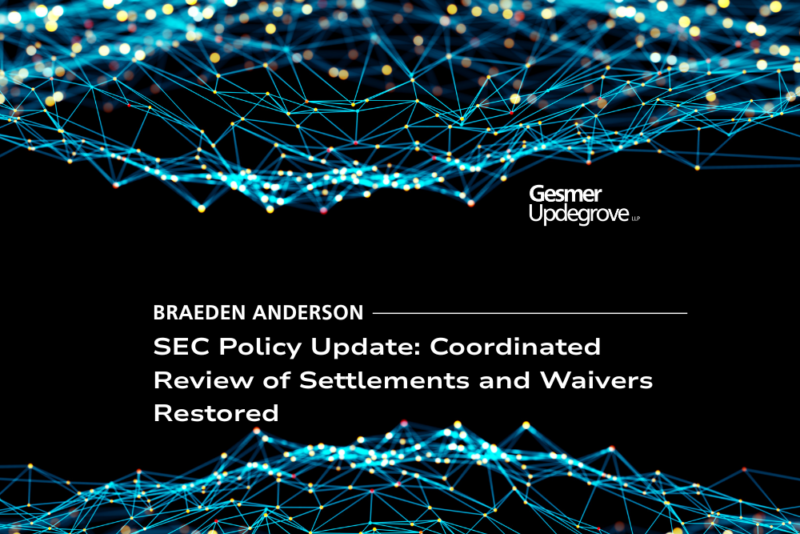
By: Braeden Anderson
On September 2, 2025, the U.S. Securities and Exchange Commission’s (“SEC”) Division of Trading and Markets and the U.S. Commodity Futures Trading Commission’s (“CFTC”) Divisions of Market Oversight and Clearing and Risk (together, the “Divisions”) issued a joint staff statement (the “Joint Statement”) as part of a new cross-agency initiative titled Project Crypto–Crypto Sprint.1 Project Crypto-Crypto Sprint reflects an effort by the agencies to coordinate on their separate crypto initiatives: SEC’s Project Crypto and CFTC’s Crypto Sprint.
This new joint effort seeks to clarify the regulatory path for U.S. exchanges to facilitate trading in certain spot crypto asset products, particularly those involving margin, leverage, or financing. For reference, a “spot crypto asset” is a cryptocurrency that is traded on a “spot” market in that it is bought and sold for immediate delivery at the current market price.
“Under the prior administration, our agencies sent mixed signals about regulation and compliance in digital asset markets, but the message was clear: innovation was not welcome. That chapter is over,” said CFTC Acting Chairman Caroline D. Pham.
The announcement reflects a broader strategic alignment consistent with the President’s Working Group on Financial Markets (“PWG”) July 2025 report, Strengthening American Leadership in Digital Financial Technology, which called for enhanced regulatory coordination and clarity to retain blockchain innovation in the United States.2
The Joint Statement does not alter existing law but confirms the Divisions’ shared view that SEC- and CFTC-registered trading venues are not precluded under current statutes and rules from facilitating trading in certain spot crypto asset products. This position, while technically interpretive, may serve as a welcome regulatory turning point for market structure innovation.
Statutory Background
The legal foundation for this initiative rests largely on § 2(c)(2)(D) of the Commodity Exchange Act (“CEA”), which requires that leveraged, margined, or financed retail commodity transactions occur on a CFTC-registered designated contract market (“DCM”) or foreign board of trade (“FBOT”), unless a statutory exception applies.3 One such exception allows for such transactions when listed on an SEC-registered national securities exchange (“NSE”).4
The Divisions have now clarified that, in their view, DCMs, FBOTs, and NSEs may permissibly list certain spot crypto asset products (even those involving retail commodity transactions) without violating applicable law or SEC rules, subject to appropriate regulatory engagement.
This interpretive position is nonbinding and reflects only the views of the Divisions’ staff. 1 Nevertheless, it signals an emerging harmonization in agency thinking and could serve as a precursor to formal rulemaking.
Key Considerations for Market Participants
The Divisions outlined several focal areas for trading venues considering listings of spot crypto asset products:
A. Margin, Clearing, and Custody Infrastructure
The Divisions acknowledge that existing rules permit clearinghouses to collaborate with custodians for safeguarding customer digital assets. The SEC’s Division of Trading and Markets and the CFTC’s Division of Clearing and Risk stand ready to engage with registered clearing agencies and derivatives clearing organizations (“DCOs”), respectively, to address implementation questions.
B. Market Surveillance and Reference Pricing
The statement emphasizes the value of inter-venue coordination. Specifically, the Divisions encourage NSEs, DCMs, and FBOTs to engage in reference price sharing, a practice intended to enhance transparency and support market surveillance objectives across platforms.
D. Fair and Orderly Market Conduct
Venues must demonstrate a commitment to fair and orderly markets. This includes adopting rules and procedures that ensure efficient execution, mitigate manipulation, and maintain orderly trading during periods of volatility, which reflects a long-standing expectation for NSEs and DCMs alike.
E. Investor and Customer Protections Amid Innovation
The Divisions expectedly reaffirm that technological advancement must not come at the expense of investor and customer safeguards. Any novel trading models or custody arrangements must meet the regulatory standards designed to protect participants in both securities and commoditiesmarkets.
Contact Us Today:
A Narrow But Strategic Opening
While the statement carries no formal legal weight, its policy implications are significant in a broad sense. By confirming that SEC- and CFTC-registered venues may seek to list spot crypto asset products, the Divisions are providing a signal of regulatory permissiveness, with caveats. Exchanges seeking to capitalize on this opportunity must proactively engage the agencies and navigate a complex web of federal requirements.
Importantly, the Divisions pledge prompt review of submissions and express a willingness to coordinate across agency lines. This should be viewed as a rare window for market participants to shape the evolving regulatory architecture around digital asset spot markets in the United States.
Conclusion
The Project Crypto–Crypto Sprint initiative reflects an incremental but important evolution in the regulatory treatment of digital assets. It demonstrates that, while jurisdictional boundaries between the SEC and CFTC persist, both agencies recognize the urgency of providing clarity and flexibility to accommodate market innovation. This level of coordination is in line with what we proposed and predicted (see Should the SEC and CFTC Merge? A Comprehensive Analysis of a Long-Sanding Debate, andersoninsight). As discussed therein, the SEC and CFTC could eventually merge, but until then, the agencies should continue to enhance their collaboration in order to harmonize regulations and address immediate regulatory gaps.
Whether this coordination leads to a more durable framework, or simply a transitional path with increased collaboration, will depend on how market participants respond and how effectively they engage with the Divisions in the months ahead. We will be monitoring this situation closely and are available to discuss any specific implications. If you have any questions, please contact Braeden Anderson at Gesmer Updegrove LLP.
Sources
1 SEC-CFTC Joint Staff Statement (Project Crypto-Crypto Sprint)
2 President’s Working Group on Financial Markets, Strengthening American Leadership in Digital Financial Technology, at 14 (July 30, 2025).
3 7 U.S.C. § 2(c)(2)(D)(iii) (2022).
4 7 U.S.C. § 2(c)(2)(D)(ii)(IV) (2022).
Meet The Author
Check Out Our Latest Publications:
- SEC CHAIR OUTLINES PLAN TO BRING CLARITY TO DIGITAL ASSET OVERSIGHT

- CRYPTO TAX: YEAR-IN-REVIEW

- The Third Circuit Reaffirms Section 10(b) and Rule 10b-5’s Standards for Misleading Statements and Scienter

- SEC Chairman Paul Atkins Announces Updates to Wells Process

- SEC Policy Update: Coordinated Review of Settlements and Waivers Restored

- SEC Provides Key Update on Treasury Clearing Rule Implementation

